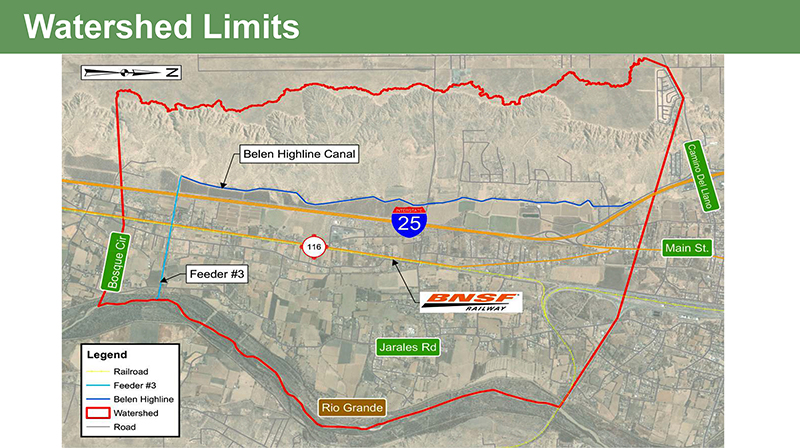BELEN — The first of many steps needed to address catastrophic flooding in Valencia County was taken earlier this month at a meeting at the Belen Public Library.
Representatives from the Middle Rio Grande Conservancy District, Valencia County and the USDA Natural Resources Conservation Service kicked off an NRCS-funded flood prevention study in the Belen watershed at the Feb. 3 meeting.
“This is one of many steps,” Valencia County Manager Danny Monette told the dozens of residents at the meeting. “We know a lot of people have been devastated. We’re trying to make progress, and coming from the private sector, government is a slow process.
“If we’re successful, we will be in the running for up to $25 million to put towards (flood prevention) projects. We are just at the planning stage.”
Monette continued, saying the county is working with the Legislature to secure funding for a socio-economic study, which is needed to establish a formal flood authority.
“We are getting there, slowly but surely,” he said.
The process to develop flood control and mitigation measures is slow and iterative, having to comply with federal rules, regulations and time lines, noted Jason Casuga, CEO and chief engineer for MRGCD.
NRCS has funded the study 100 percent to date, to the tune of $665,532.
“This is part of the process to get access to funds, which is primarily federally driven and funded. We are able to do this without cost share,” Casuga said. “If we are successful, we can leverage up to $25 million for improvements within the study area.”
The majority of the 250,000 acre study area is south of the city of Belen, starting near the southern most Belen exit on Interstate 25, mile marker 191, and stretching south to near Bosque Circle a few miles south of the MRGCD’s feeder 3 ditch, which carries water back to the Rio Grande.
The western boundary of the study area begins at the escarpment on the west mesa and the east limit is the river itself.

Courtesy of Wilson & Company
The area of study for the Belen Watershed Flood Prevention Project is outlined in red.
The district applied for the NRCS grant in 2019 originally, Casuga said, and it’s meant to address flooding in rural areas and protect agricultural activities there.
“A large portion of the study area has ongoing agriculture use. Feeder 3 is a piece as the last outlet to the river. Anything that happens to the north, that’s the last significant route to the river,” he said. “Ultimately, we have to get water back to the river and safely route it so it stops doing damage.”
NRCS-funded watershed study grants have a maximum allowable area of 250,000 acres, Casuga continued, explaining the area selected for study was based on “trying to back into key pieces of infrastructure, stay rural and agricultural and not exceed the acres. Or else we don’t qualify for this mechanism of funding. These kinds of improvements cost a lot of money. The cap is $25 million, and we are not sure that will cover all the improvements needed for that area.”
While most of the study area is outside the city limits, Casuga said the district has been actively working with Belen officials on infrastructure improvements in the area around the Belen Highline Canal and Belen High School.
“We need to hold a public meeting specifically about those efforts, which are outside of this study area,” he said.
Casuga said the first phase of the three-phase project is to get public comment to make sure the district and county have a good understanding of the impacted areas.
“Contractors and subcontractors will be reviewing all the available materials. We have to go through the environmental compliance process,” he said. “The feds are particular about the steps we take. We want to get to the end point to access dollars and alleviate flooding.”
Now that the first public meeting has been held, the district and county will continue gathering input and public feedback for most of the rest of this year.
The next milestone is a draft watershed plan by April 2024, followed by a second public meeting and collection of additional feedback and input from residents. The goal is to have the final plan completed by December 2024 and begin the required 30-day public comment period in January 2025.
Design and construction would follow but precise dates haven’t been determined.
As the non-federal sponsors of the project, the county and MRGCD are responsible for permits, any land right acquisition needed, utilities coordination and long-term operation and maintenance.
“‘Long-term operation and maintenance.’ This is the biggest thing we have to do,” Casuga said. “NRCS has to know there are entities here that have the ability to maintain the improvements they will invest in and build.”
Since this is the very beginning of the planning process, just what those improvements might be are still unknown. During the meeting, a slew of solutions were presented, including culverts and channels, green infrastructure, terracing and ponds.
“We will consider several project alternatives and weigh those against environmental, social and economic impacts, public concerns and existing conditions,” he said, encouraging community members to provide feedback and historical flood information about the area.
“This is a collaborative process. A document based on our feedback has to be produced. We will have to overcome blind spots. We don’t have all the information. Are there things we’re not seeing?”
Any comments, input or information about the study should be sent to [email protected].
Belen Watershed Flood Prevention Project
Julia M. Dendinger began working at the VCNB in 2006. She covers Valencia County government, Belen Consolidated Schools and the village of Bosque Farms. She is a member of the Society of Professional Journalists Rio Grande chapter’s board of directors.
















